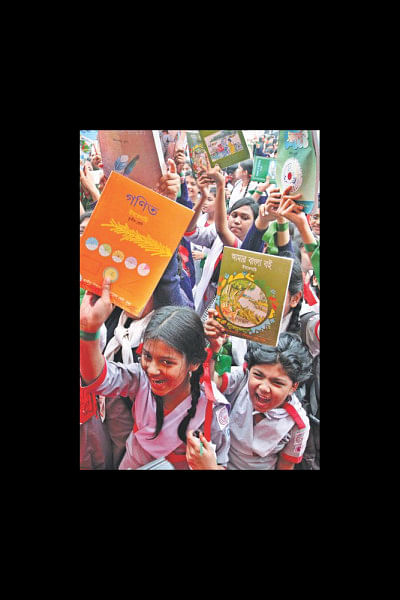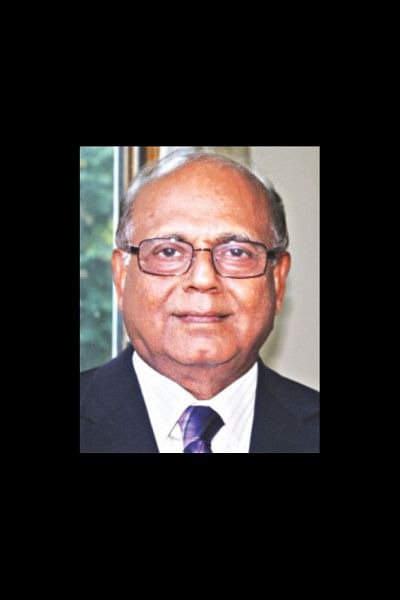Keeping the promise to our children


Mariam, a bright nine-year old girl with dangling ponytails, sat in one of the middle rows in a class of about 50 students in a rural primary school. The teacher, Selina, a young and earnest woman, was writing some difficult words on the blackboard from the day's Bangla lesson. With her permission, a visitor asked Mariam to read a few lines from the Bangla newspaper that he had brought with him. Mariam stood up and tried to read. She read haltingly, stumbling on the headline and the text, pronouncing some words incorrectly and missing out a few.
Selina, the teacher, said, “Sir, Mariam can read well. Please ask her to read a passage from the Bangla textbook.” The visitor complied and sure enough, Mariam opened a page from the book and read more confidently and with fluency.
Mariam and about 25 other girls sat on one side of the room elbow-to-elbow on wooden benches with long desks in front of them. About the same number of boys sat on the other side. It is likely that the reading episode could be repeated with Riaz, one of the boys.
The good news is that in Mariam and Riaz's school, boys and girls are roughly equal in number. Selina, the teacher, has a Bachelor's degree and has received pedagogy training for a year from the Primary Teachers' Training Institute. Mariam and Riaz have textbooks provided free of cost.
The other side of the story is that Mariam and Riaz have not acquired enough functional reading skills – a prime competency to be achieved through primary education. An assessment commissioned by the Directorate of Education itself has shown that only 25 percent of class five students achieve the expected competencies in Bangla and mathematics.
An average of 50 students in a primary class is just too large – in some cases the number reaches 100; it should be 30 or less. The students sit in rows in crowded rooms, with no chance to move or engage in any learning activity with peers. The teacher mostly stands in front of the students and repeats passages from the textbook and writes on the blackboard. With a large class and amid pressure to just “complete” the lesson, she has few options.
The snapshot of the primary school class points to successes in expansion of schooling and gender equality in accessing education. It is also noteworthy that more students are coming and staying in school, more women are in teaching, and more teachers have higher educational qualifications and pedagogy training.
The snapshot also portrays various basic deficits in resources, facilities and capabilities of people and their mindsets regarding education. Problems crop up on diverse issues, sometimes unexpectedly. Decision-making and management do not reflect a comprehensive, long term and systemic view. We see the decision-makers and managers bogged down in “fire-fighting” when problems arise – be it about admission of students to school, leakage of question papers for public examinations, recruitment process of teachers, anomalies in their salaries, and corruption and incompetence at different levels.
At this juncture of socio-economic development of Bangladesh, a few issues regarding education deserve to be highlighted.
Resources: The downward trend in public funds for education, as a share of the GDP and the national budget, in the period since the present government took over in 2009, is inconsistent with the government's own proclaimed goals. One of the lowest positions globally in this respect is not acceptable and must be reversed. Within the medium term, the proportion of GDP for public education budget should be raised to at least 4 percent.
New thinking about teachers: The major expenditure item in education is the teaching personnel. New thinking is needed to make teaching one of the first career choices for talented young people, rather than the last one. A ten-year plan has to be taken to bring about this transformation – learning from both developed OECD countries and those in East Asia including China.
Three key elements in this plan would be: (a) creating a National Teaching Service Corps (NTSC) with high remuneration and prestige, (b) attracting bright young people with stipends and the lure of an NTSC job into a teacher preparation track to be introduced in the fourth year general degree programme (BA or BSc) with education as a subject, and (c) ensuring high quality of this degree programme by enforcing quality standards in at least 100 government degree colleges in the country.
A nucleus of quality teaching personnel in thousands of primary and secondary schools could be created in ten years by placing two or three NTSC teachers in each school. A small beginning has been made in this respect with Teach for Bangladesh in line with the Teach America initiative.
Attracting students to science and math: Students in high schools are turning away from science and math because competent and inspiring teachers, learning materials and laboratories are lacking. STEM (Science, Technology, Engineering and Math) is the key to developing 21st century human capabilities. But the foundation has to be laid out in the primary grades and then the right teachers and facilities have to be ensured in secondary school.
Out-of-school children: At least four million children of primary school age are still out of school, either because they have never enrolled in school or because they have dropped out early. Bangladeshi NGOs, led by BRAC, pioneered the non-formal second chance primary education programme in the 1980s which has been successfully scaled up. A second chance programme must be a part of the main strategy for universal primary education, but this can work only if a partnership is created with the NGOs which have proven their commitment and capacity.
One Ministry for schools: Like most countries in the world, one national Ministry should be responsible for school education – K-12 – to overcome many obstacles to curriculum articulation, teacher preparation, extension of universal education progressively to higher grade levels, and coordinated attention to the development of school education. The creation of a primary education division in the 1990s and then establishing a Ministry for education up to grade five (or even up to grade 8) makes little sense.
Quality pre-primary: A good start has been made in expanding a year of pre-primary education, now serving over two-thirds of those entering primary school. Expansion of quality preschools was foreseen to be undertaken through GO-NGO collaboration by coordinated planning in each upazila. A GO-NGO collaboration guideline was prepared by the Ministry of Primary and Mass Education, but was not implemented for lack of public funding for NGO contribution. A programme without acceptable quality for young children can do more harm than good.
Lifelong learning: The principles and practice of lifelong learning have come to the fore again in the context of SDG 2030 and SDG-4 on education - Ensure inclusive and quality education for all and promote lifelong learning. To make lifelong learning a reality, a network of community learning centres (CLCs) offering relevant learning activities and supported by essential resources, complementing formal education, must be built up. NGOs have shown their commitment in this area with some 5,000 gonokendros (people's centres) run by different organisations. Core resources have to be provided by the government and partnership modalities have to be developed among government, NGOs and communities to build a nationwide network of CLCs.
These priorities are interconnected – more resources have to be committed, these have to be used better for the right purposes, and the management and capacity strengths have to be developed to fulfill the priorities. This can be done if we capitalise on our assets and achievements and learn the lessons from our experience.
The writer is Professor Emeritus at BRAC University.

 For all latest news, follow The Daily Star's Google News channel.
For all latest news, follow The Daily Star's Google News channel. 



Comments